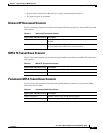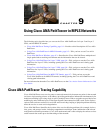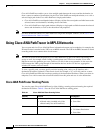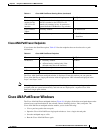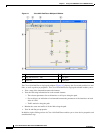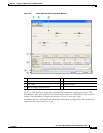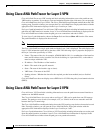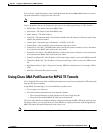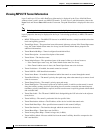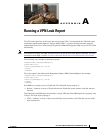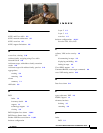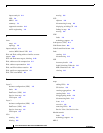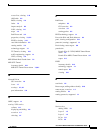
9-6
Cisco Active Network Abstraction 3.6.6 MPLS User Guide
OL-19192-01
Chapter 9 Using Cisco ANA PathTracer in MPLS Networks
Using Cisco ANA PathTracer for Layer 3 VPN
Using Cisco ANA PathTracer for Layer 3 VPN
Cisco ANA Path Tracer uses VRF routing and label switching information to trace the path from one
VRF interface to another. If you choose a start and endpoint from the right-click menu, you can open the
Cisco ANA PathTracer for Layer 3 VPNs. The Cisco ANA PathTracer multipath window shows the VPN
topology map. From this window, you can open the Cisco ANA PathTracer single-path window with the
appropriate VPN information displayed in the Layer 2 and Layer 3 tabs.
For Layer 3 path information, Cisco ANA uses VRF routing and label switching information to trace the
path from one VRF interface to another. Layer 3 Cisco ANA PathTracer information is displayed in the
Cisco ANA PathTracer window when the path goes over connections and ends in VRFs.
To view Layer 3 path information, choose the Layer 3 tab and choose Show All from the View menu.
The path information is displayed in the active tab.
Note Selecting a device or link on the map automatically highlights the related parameters in the table.
The Cisco ANA PathTracer single-path window with the Layer 3 tab is displayed. The table displays the
Layer 3 VPN information on the device that has a VRF. The following Layer 3 properties displayed in
the Layer 3 tab relate specifically to VPNs:
• Name—The name of the site, for example, ATM4/0.100(10.0.0.1) is a combination of the interface
name and IP address used to reach the site. Each site belongs to a particular VPN, so the address
must be unique within the VPN.
• IP Address—The IP address of the interface.
• Mask—The mask of the specific network.
• State—The state of the interface (up or down).
• VRF Name—The name of the VRF.
• Sending Alarms—Whether the alarm for the required port has been enabled (true) or disabled
(false).
Cisco ANA PathTracer does not display or trace EXP bits for L3 VPNs that policy-based tunnel selection
(PBTS).
Using Cisco ANA PathTracer for Layer 2 VPN
Cisco ANA uses VC ID and label switching information to trace the path from one tunnel interface to
another over the MPLS network.
The Cisco ANA PathTracer also covers end-to-end Layer 2 VPN service paths from one CE router to
another. The path goes over circuits (for example, a VC) or VLANs in the access networks and LSP
between the Layer 2 tunnel edge.
The Cisco ANA PathTracer multipath window shows the VPN topology map for the relevant devices and
links. From this window, you can open the Cisco ANA PathTracer single-path window with the
appropriate VPN information displayed in the Layer 2 and Layer 3 tabs.
For Layer 2 path information, Cisco ANA uses VC ID and label switching information to trace the path
from one tunnel interface to another. Layer 2 Cisco ANA PathTracer information is displayed in the
Cisco ANA PathTracer window when the path goes over pseudowire tunnels.




